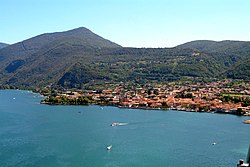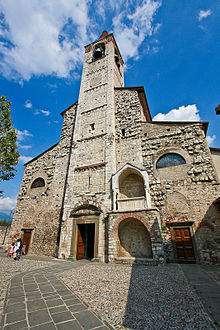| Iseo | |
|---|---|
| Comune | |
| Comune di Iseo | |
 Iseo Iseo | |
| Location of Iseo | |
  | |
| Coordinates: 45°39′N 10°3′E / 45.650°N 10.050°E / 45.650; 10.050 | |
| Country | Italy |
| Region | Lombardy |
| Province | Brescia (BS) |
| Frazioni | Covelo, Pilzone, Clusane |
| Government | |
| • Mayor | Marco Ghitti (Fratelli d'Italia) |
| Area | |
| • Total | 25 km (10 sq mi) |
| Elevation | 186 m (610 ft) |
| Population | |
| • Total | 9,159 |
| • Density | 370/km (950/sq mi) |
| Demonym | Iseani |
| Time zone | UTC+1 (CET) |
| • Summer (DST) | UTC+2 (CEST) |
| Postal code | 25049 |
| Dialing code | 030 |
| Patron saint | St. Vigilius of Brescia |
| Saint day | 26 September |
| Website | Official website |
Iseo (Brescian: Izé) is a town and comune in the province of Brescia, in Lombardy, Italy, on the south shore of Lake Iseo. It is bounded by the communes of Provaglio d'Iseo, Sulzano, Polaveno and Paratico.
It has the first monument ever built of Giuseppe Garibaldi, erected in 1883.
Main sights
| This section does not cite any sources. Please help improve this section by adding citations to reliable sources. Unsourced material may be challenged and removed. Find sources: "Iseo, Lombardy" – news · newspapers · books · scholar · JSTOR (August 2022) (Learn how and when to remove this message) |

- Oldofredi Castle, built between the end of the 11th century and the beginning of the 12th century, on the site of the Torrazzo, a rock at the edge of the city. It is one of the best preserved fortified complexes of early medieval military history. This fortress has square corner towers, screened by quadrangular crossbars on an inclined base. It was named after the Ghibelline Oldofredi family from Iseo. The large tower of the southern wing is the eldest part. It has a square base of 10 metres, a height of 12 metres. Its walls are 2 metres thick. The castle was set afire by the troops of Frederick Barbarossa during his Italian war in the mid-12th century. It was restored by Giacomo Oldofredi in 1161. During the 13th and 14th century, a rectangular castle was added to the fortified building. The castle was then surrounded by a deep moat, carved out of the solid rock. In the 14th century the castle belonged to the Scaliger family of Verona. The castle lost much of its importance when the political control of the Republic of Venice became stronger. It was then bought by the Celeri family. Its upkeep became so expensive that in 1586 the castle was transformed into a monastery for Franciscan friars. The frescoes on some walls of the building date from the 17th-18th centuries. The friars were forced to leave the building in 1797 during the Napoleonic occupation. It became a private property and changed into a block of flats (some are still inhabited) and a spinning mill. The building was bought by the municipality of Iseo and restored in the 1960s. It is now used as a public library, a war museum and can be used for civil wedding services.
- Sanctuary of Our Lady of the Snow (Santuario Madonna della Neve) was built on the remains of the ancient church of St. Stephen, for popular devotion during the plague. On 15 April 1655 the foundation stone was laid for a new sanctuary after the miraculous healing of a man who crawled on all fours and suddenly could walk normally. He ascribed it his prayer to the fresco of the Holy Family in an aedicule on the wall surrounding the ancient church.

- Pieve di St. Andrea. It is believed that the church was founded in the 6th century by Bishop San Vigilio on the site of a Roman temple. It was subsequently reconstructed in the 12th century in Lombard style. Over the centuries the parish church was renovated several times. At the beginning of the 19th century Rodolfo Vantini renovated the interior in neo-classical style. The church is characterised by an unusual Romanesque bell tower incorporated into the centre of the façade. The church is so ornate and is regularly used for weddings. It is just a couple of minutes walk to the lake shore and also Garibaldi square, with the Garibaldi monument and "Vantini" Palace, the Town Hall. On the right-hand side of the portal there is a 14th-century Gothic arch by Giacomo Oldofredi. Inside there are frescoes by Angelo Inganni and one St Michael Archangel by Francesco Hayez. In the presbytery there are frescoes by Ponziano Loverini and Giuseppe Teosa.
- Garibaldi square, with the Garibaldi monument and "Vantini Palace", the Town Hall.
Transportation
The railway station of Iseo is served by regional trains to Brescia and Edolo. Iseo is connected to several other towns on Lake Iseo by ferry.
Twin towns
Iseo is twinned with:
 Tamsweg, Austria
Tamsweg, Austria
References
- "Superficie di Comuni Province e Regioni italiane al 9 ottobre 2011". Italian National Institute of Statistics. Retrieved 16 March 2019.
- ISTAT Archived 2016-03-03 at the Wayback Machine
- "SOMS Iseo". Archived from the original on 2014-05-12. Retrieved 2014-05-12.
- "Ferry schedule". Archived from the original on 2012-11-26. Retrieved 2014-05-12.
External links
 Iseo travel guide from Wikivoyage
Iseo travel guide from Wikivoyage- Photos and information about Iseo and the surrounding region
- Official website of Iseo tourism
| Lake Iseo (Lago d’Iseo, Sebino) | ||
|---|---|---|
| Location | ||
| Settlements | ||
| Islands | ||
| Rivers |
| |
| Valleys | ||